Azalea: description, planting and care features

The desire to equip your home as best as possible, to create an atmosphere of comfort and beauty is inherent in every normal person. General ideas about comfort are far from unambiguous, but most of us will certainly prefer to contemplate a blooming green piece of nature at home. One of the objects of the "green island" can be an indoor azalea flower.

Description
Azalea (Azalea) is an abundant and long-flowering plant from the genus of rhododendrons of the heather family. Blooming azalea with its beauty is a serious competitor to the queen of flowers - the rose, for which it is highly valued among florists and amateur florists. This is a short plant with highly branched shoots and lanceolate leaves, densely pubescent underneath. As a result of many years of work of breeders, many varieties of azalea have been created, the variety of decorative characteristics of which is amazing.


Flowering begins at the age of 3-4 years with single flowers or inflorescences of various sizes and shapes (simple, double, semi-double, fringed). During the flowering period, the leaves are not even visible behind the luxurious inflorescences. Azalea flowers are painted mainly in white, pink or red colors and all kinds of variations in their transitional shades. This plant has anti-inflammatory and bactericidal action, relieves severe fatigue, clarifies thoughts. It is enough to sit next to a fragrant flower for a few minutes, inhaling its delicate aroma and contemplating the amazing beauty of the exuberant flowering, in order to feel the beneficial effect of such aromatherapy.

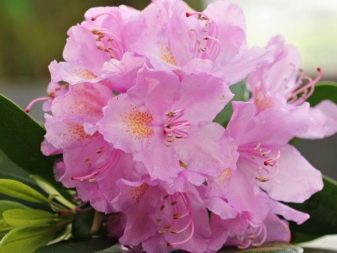
Some modern varieties that have good winter hardiness are successfully used in the design of flower beds and recreation areas in parks and gardens, but in our latitudes, it is mainly practiced to grow azaleas at home and in greenhouses, where it is easier to create the necessary conditions.
Types and varieties
For home growing, amateur flower growers prefer to choose mainly 2 types of azaleas - Indian and Japanese, but they also present many interesting opportunities for the implementation of creative ideas in creating home collections, since breeders, with their painstaking work, managed to bring out many varieties of these plants with various decorative properties. ... Indian species of azaleas (Sims rhododendron) It is a compact bushes (up to 50 cm) with different flowering periods, has a varied color of inflorescences and differs in the shape and size of flowers. Widespread.

Japanese azalea species (rhododendron blunt) has a very abundant lush flowering. The formed crown of a small bush (30-50 cm) during the flowering period is literally strewn with flowers, which ensured the high popularity of hundreds of varieties of this species among florists. The main difference between the Japanese azalea and the Indian one is the smaller flowers. In the spring, when the danger of frost has passed, pots of Japanese azalea can be taken out into the garden. It is possible to grow some varieties outdoors in gardens.


The existing varieties of azaleas are classified into groups:
- early flowering bloom at the very beginning of winter in December - January;
- medium flowering will delight you with flowering in January - March;
- late blooming bloom at the end of the azalea flowering season in February - April.


Among the varieties of azalea, the most popular are Nabucco, Golden Lights, Pontiyskaya, Arima, Kiev Waltz, Snezhinka, Scarlet Flower, Melina.
Having picked up several varieties for growing with different flowering periods and properly caring for them, you will admire the amazing azalea flowering almost all winter.


Reproduction methods
When growing azaleas at home, 2 main breeding methods are used: cuttings and dividing the bush.


Cuttings
The best time for such a procedure is spring and early summer. Cuttings (7-10 cm in size) are harvested from a strong semi-lignified shoot. Cuttings are cut obliquely with a sharp disinfected knife and make sure that each cuttings have kidneys. The lower leaves need to be cut to half the petiole, the rest - to half the leaf plate. The cuttings are placed in the lower cut in the "Kornevin" solution (for better root formation) and incubated for about 6 hours.


Then the soil is prepared in a shallow bowl (a little gravel and river sand, and on top there is coniferous earth or sphagnum moss with peat). Cuttings are placed in this substrate to a depth of 1.5-2 cm at a distance of 3-4 cm from each other, watered abundantly and covered with a transparent bag to create "greenhouse" conditions. Waiting for the roots to appear, the plantings are regularly watered and sprayed with warm, settled water. To avoid the appearance of mold, daily aeration is carried out for an hour and then covered again. When flower buds appear, they must be immediately removed, and the stretching cuttings must be pinched.
Under these conditions, the cuttings take root in about 1.5-2 months. When the cuttings show signs of the formation of their own shoots, they need to be transplanted into pots.


Dividing the bush
This procedure is possible only with healthy adult plants, which are already 3-4 years old. It is better to do this in the spring during a period of high activity and the greatest mobilization of the defenses of plants. The peculiarities of the root system of azaleas should be taken into account. - the presence of many small, but important roots and specific microflora around them. There is a risk that cultivation problems will arise with the intervention. The division of the bush is carried out by experienced growers with the utmost care with sharp disinfected tools. New bushes for successful recovery will require close attention and intensive care for a whole year.
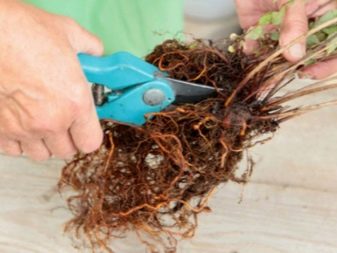

There is also a seed method for propagating azaleas, but it is used mainly in breeding work. This is a difficult laborious process, so it is better not to plant azalea seeds at home.
Landing
Growers often buy soil for planting azaleas in specialized stores - there it is sold ready-made with an optimal nutritional composition for acidophilic ("acid-loving" pH 4-4.5) plants (azalea is one of them). Self-prepared soil should have an acidic reaction and contain coniferous soil, river sand and moss (2: 1: 1). If you have grown planting material from cuttings or divided a bush, plant small azaleas or parts of the bush in separate shallow pots. It usually takes 2-3 years from planting to flowering.

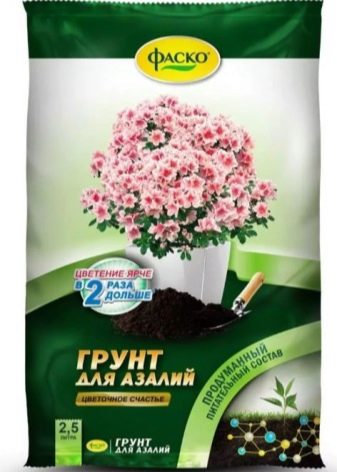
If you want to buy a ready-made bush, carefully consider the choice. Examine the bush from all sides for signs of pests and dried leaves, which indicates that the plant is not very healthy. It is better to stop the choice on the plant where there are still few fully blooming flowers, or they are not at all, but only unblown buds. If most of the flowers are still in the budding stage, the plant will more easily tolerate a “change of residence”.
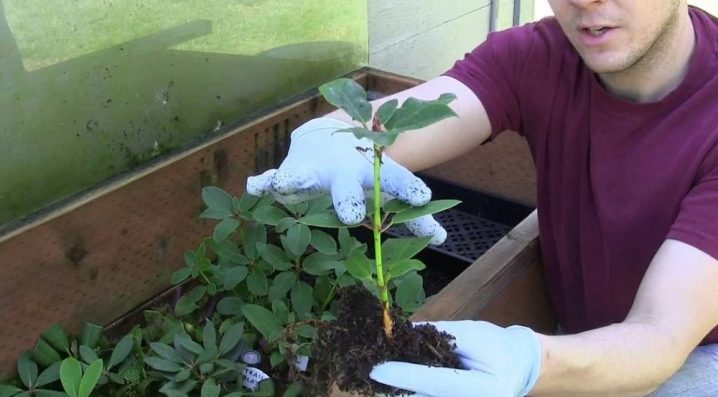
Do not transfer the azalea to another container immediately after purchase. The plant needs adaptation to new conditions of detention. This will take about 2 weeks. If a flowering bush has been purchased, wait until the end of flowering, and only then transplant it into a new soil.Azaleas have a superficial root system, so choose a shallow flowerpot. Transplant with extreme caution using the transhipment method, in which an earthen lump is preserved, and the thin micro-roots of the plant are least damaged. Do not deepen the root collar.


Until the age of three, when a healthy plant is actively growing and gaining strength, the azalea is transplanted every year, and then - as needed, about once every 3 years. When transplants, dried flowers and shoots with growth defects are removed - weak or strongly overgrown, curved.
Care rules
The home beauty of the azalea is a rather finicky flower. Sudden changes and fluctuations in temperature are unacceptable, she prefers constant coolness. If your lifestyle is "from the same category" and you like cool air in the apartment, you will successfully "make friends" with her, and if you prefer a warm house with temperatures much higher than +20 degrees, you should think again about the advisability of growing azaleas - there is a high probability the fact that it will not work to grow it.


If you are still thinking about purchasing this capricious beauty in your house, start by choosing a place where you plan to "settle" her. Azaleas need bright and at the same time diffused light (without direct sunlight), so a southern window will not work for her. It is optimal to place the pot with the plant on the eastern windowsill, as an option - on the western or northern ones. The optimum indoor temperature in summer is +19.21 degrees, in winter - +16.19 degrees.
In addition, during the budding period, the temperature should be lowered to +11.13 degrees. Needless to say, it is extremely difficult to achieve such conditions in city apartments - after all, the heating season will open almost simultaneously with the beginning of budding in azaleas.
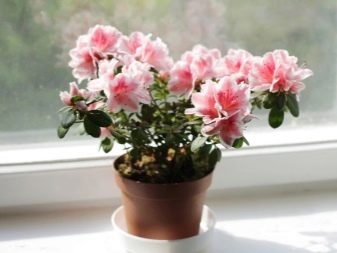

But here, too, true lovers of room flora find a way out. In autumn, if there is a loggia, its space is used. Various models of air conditioners (mounted, floor standing, portable) of a wide price range have become an excellent option in modern conditions. By placing such an air conditioner near the plant, you can easily get a given thermal regime and "please" a capricious beauty.


High humidity is a prerequisite for these flowers. With excessive dryness, the plant begins to throw off the leaves. Constantly spray the plant and the whole room with settled or melt water, use humidifiers, put a wet towel on the heating radiator or hang it with a thick cloth. To control the amount of humidity in a room, it is a good idea to purchase a psychrometer (a device for measuring humidity) in order to respond in a timely manner to critical indicators.

Watering
The soil in the pot should always be moist. For azaleas, neither overflow, nor underfill, nor stagnant water in the pan are allowed. Ideal for irrigation are rain and melt water at room temperature, as an option - settled from the tap. It is recommended to acidify the soil 2 times a month (not more often!) When watering with water with the addition of a few drops of lemon juice or citric acid crystals (2-3 drops or 2-3 crystals per 1 liter of water). Do not loosen the soil - azaleas have a superficial root system, thin vulnerable roots - there is a risk of damaging them.
If it dries up and the soil has hardened, place the pot in a large container of water for 2-3 hours, the plant will "drink" through the drainage holes in the bottom of the pot, then put it on a tray and drain off excess water when it drains.


Plant formation
Systematic pinching and pruning of shoots is one of the mandatory procedures when growing azaleas to stimulate the formation of flowering branches. Young twigs are cut to the 5th leaf, which contributes to their abundant flowering.From the practice of experienced flower growers, it is known that the more lush and thicker the greens on the azalea bush, the smaller the flowers, therefore, when forming the crown, they try to remove weak and overgrown branches as soon as possible without harm to the plant. The procedure is carried out in the spring after flowering.

Top dressing
The formation of many buds and inflorescences of azaleas requires constant replenishment of strength and nutritional reserves, therefore regular feeding is an important factor in successful cultivation. Mineral fertilizers of a special composition have been developed for rhododendrons. In specialized shopping centers you can find a top dressing called "Azalea". In the warm season, feeding is needed once a week, and in winter, much less often - once a month, while strict adherence to the instructions for use is mandatory.


Diseases and pests
In nurseries, plants are brought to the stage of flowering artificially (special temporary additives are added to the soil to maintain the freshness and flowering of plants). In shipping pots with a small amount of soil mixture, the root system almost does not develop, so a newly acquired azalea bush will require close attention from the first days. It is not surprising that when you move from the store to the room on the windowsill, a seemingly fragrant bush can wither after a short time, flowers and leaves begin to dry out, the plant gradually fades away, and its resuscitation becomes impossible.

A novice grower in a similar situation mistakenly creates the opinion that azalea is a disposable flower and it is extremely difficult to grow it at home, but this is not so. With appropriate preparation and proper care, the beauties of azaleas actively grow, bloom profusely and for a long time and delight the owners with their luxurious appearance.
Ideally, if you follow all the recommendations for growing azaleas, the plants will not hurt. But in real conditions it is not always possible to create all conditions of detention in accordance with the recommendations, providing complete care according to the rules. Let us tell you what "misfortunes" can happen to azaleas in the process of growing them. Improper care: insufficient or excessive watering, exposure to direct sunlight, insufficient illumination, high or low temperatures, unsuitable soil, untimely feeding will inevitably lead to deviations in the development of the plant.
- The appearance of withered yellow leaves will indicate insufficient watering. Adjust the procedure as soon as possible, check the water quality, spray, check the illumination - the problem will disappear.
- The appearance of rust and gray rot on the leaves indicates non-compliance with the temperature regime in the room. Correct the situation - optimize the heat regime and remove spoiled leaves from the plant. This will restore the flower's defenses.
- Excessive moisture in the soil can lead to late blight disease and to the complete loss of the plant.
- Yellow spots on the edges of the leaves - a sign of chlorosis in plants due to a lack of iron and magnesium in the soil. It is necessary to feed the flowers with appropriate fertilizers and microelements.




Let's talk about the disease separately fusarium... If the edges of the leaves (and sometimes the stems) turn black, this is fusarium caused by a fungal or viral infection with improper care (excessive humidity, temperature fluctuations). Blackening of leaf tips can cause insect black thrips. Affected leaves fall off, leaving completely bare branches.
It is possible to save the azalea only with early detection of the problem. Immediately get rid of parasites by treating with special agents (emulsion "Karbofos", "Fundazol"), for better efficiency, treat the area surrounding the flower (glass, frame, window sill, pallet).


Cut off the remaining affected leaves without touching the branches (even bare ones), carefully check the roots, transplant the plant into new soil (disinfect the soil before planting) and place the pot in a room with a temperature of +20.22 degrees in diffused light without sunlight. Providing proper care and conditions in the future, one can hope for a successful flower recovery.
Unfortunately, a plant with a late stage of fusarium disease will not be able to recover.

It is also possible that azalea bushes are affected by various pests (spider mites, whiteflies, aphids, scale insects)... Insects suck the juices from the leaves and stems of plants, gnaw them, causing serious harm. First, you can try to treat the bush with soapy water, but if this does not work, use special chemicals (Aktellik, Fitoverm, Aktara, Karbofos).


Features and rules of care for large species groups of plants have many similar elements. Illumination, temperature, humidity - these are the "three whales" on which the whole range of measures for growing plants rests. The correct agrotechnical complex of care will help to minimize problems with plant diseases.
When you accidentally meet a blooming azalea (in a store, in a greenhouse, at your friends'), the imagination involuntarily transfers it to the interior of your house or apartment. In addition to its extraordinary beauty, azalea is remarkable in that it blooms in the cold season. Most indoor plants at this time are dormant and do not bloom, outside the window there is a dull monotony, there is an acute lack of bright colors and positive emotions. Azalea blooming magnificently at this time looks gorgeous, and its fragrance will give you double joy more than once.

For information on how to properly care for an azalea, see the next video.







































































































The comment was sent successfully.